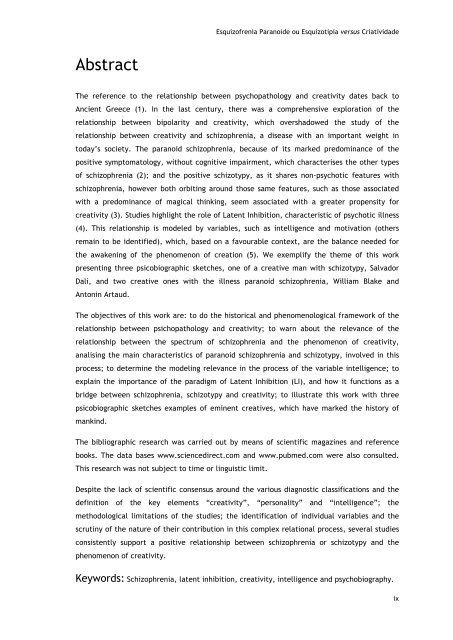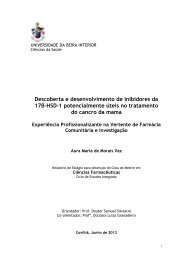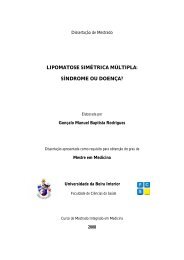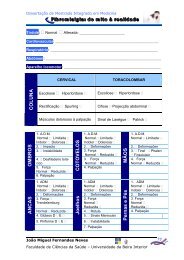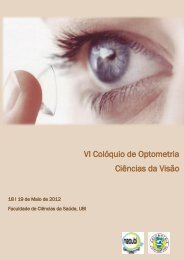Esquizofrenia Paranoide ou Esquizotipia versus Criatividade
Esquizofrenia Paranoide ou Esquizotipia versus Criatividade
Esquizofrenia Paranoide ou Esquizotipia versus Criatividade
Create successful ePaper yourself
Turn your PDF publications into a flip-book with our unique Google optimized e-Paper software.
Abstract<br />
<strong>Esquizofrenia</strong> <strong>Paranoide</strong> <strong>ou</strong> <strong>Esquizotipia</strong> <strong>versus</strong> <strong>Criatividade</strong><br />
The reference to the relationship between psychopathology and creativity dates back to<br />
Ancient Greece (1). In the last century, there was a comprehensive exploration of the<br />
relationship between bipolarity and creativity, which overshadowed the study of the<br />
relationship between creativity and schizophrenia, a disease with an important weight in<br />
today’s society. The paranoid schizophrenia, because of its marked predominance of the<br />
positive symptomatology, with<strong>ou</strong>t cognitive impairment, which characterises the other types<br />
of schizophrenia (2); and the positive schizotypy, as it shares non-psychotic features with<br />
schizophrenia, however both orbiting ar<strong>ou</strong>nd those same features, such as those associated<br />
with a predominance of magical thinking, seem associated with a greater propensity for<br />
creativity (3). Studies highlight the role of Latent Inhibition, characteristic of psychotic illness<br />
(4). This relationship is modeled by variables, such as intelligence and motivation (others<br />
remain to be identified), which, based on a fav<strong>ou</strong>rable context, are the balance needed for<br />
the awakening of the phenomenon of creation (5). We exemplify the theme of this work<br />
presenting three psicobiographic sketches, one of a creative man with schizotypy, Salvador<br />
Dalí, and two creative ones with the illness paranoid schizophrenia, William Blake and<br />
Antonin Artaud.<br />
The objectives of this work are: to do the historical and phenomenological framework of the<br />
relationship between psichopathology and creativity; to warn ab<strong>ou</strong>t the relevance of the<br />
relationship between the spectrum of schizophrenia and the phenomenon of creativity,<br />
analising the main characteristics of paranoid schizophrenia and schizotypy, involved in this<br />
process; to determine the modeling relevance in the process of the variable intelligence; to<br />
explain the importance of the paradigm of Latent Inhibition (LI), and how it functions as a<br />
bridge between schizophrenia, schizotypy and creativity; to illustrate this work with three<br />
psicobiographic sketches examples of eminent creatives, which have marked the history of<br />
mankind.<br />
The bibliographic research was carried <strong>ou</strong>t by means of scientific magazines and reference<br />
books. The data bases www.sciencedirect.com and www.pubmed.com were also consulted.<br />
This research was not subject to time or linguistic limit.<br />
Despite the lack of scientific consensus ar<strong>ou</strong>nd the vari<strong>ou</strong>s diagnostic classifications and the<br />
definition of the key elements “creativity”, “personality” and “intelligence”; the<br />
methodological limitations of the studies; the identification of individual variables and the<br />
scrutiny of the nature of their contribution in this complex relational process, several studies<br />
consistently support a positive relationship between schizophrenia or schizotypy and the<br />
phenomenon of creativity.<br />
Keywords: Schizophrenia, latent inhibition, creativity, intelligence and psychobiography.<br />
ix


